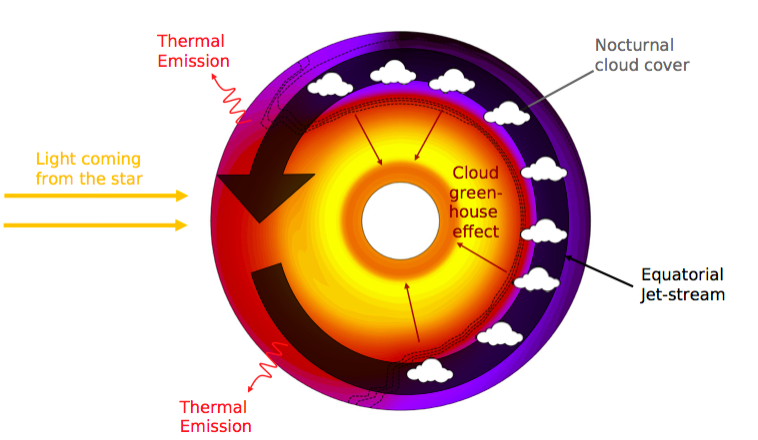[Le LMD publie] On the effect of clouds in the atmospheres of “Hot Jupiter”-type exoplanets

Illustration of the atmospheric circulation and thermal structure modeled using Generic PCM. The color gradation represents the spatial evolution of temperature, from the warmest on the day side (yellow-red) to the coldest on the permanent night side (purple).
As of February 1, 2024, more than 5,606 exoplanets have been discovered. One category of exoplanets, the so-called ‘Hot Jupiters‘, are the easiest to detect. These are gas giants such as Jupiter, whose mass is comparable to or greater than that of Jupiter and whose temperature fluctuates between 500 and 1800 °C. These planets are in resonance with the star they orbit: They therefore always show the same side to their star as the Moon does to Earth. The side facing the star is therefore very hot (more than 1000°C); in contrast to the “cold” side (still more than 500°C!), which is always at night. Numerous observations have suggested the presence of clouds on this permanent night side, but their composition remains mysterious. On Earth, we know that water clouds have a strong influence on the climate, for example through their greenhouse effect. Therefore, a scientific team, in which some LMD members are involved, wondered what kind of clouds exist on these exoplanets and what influence they have on these “exoclimates ».
Led by Lucas Teinturier, PhD student at LMD and LESIA, the team improved a climate model that can be used to study all exoplanets (the Generic Planetary Climate Model) and applied it to ont of these Hot Jupiter, the planet WASP-43b. The numerical simulations carried out by the team show that clouds that form on the night side of the planet have a warming greenhouse effect on the atmosphere, just like on Earth. Depending on the composition and size of the clouds, they can reduce the wind speed of the equatorial jet stream. By comparing their model with observations from the Hubble, Spitzer and James Webb telescopes, Lucas Teinturier and his colleagues were finally able to demonstrate that the inclusion of clouds was necessary to explain the spectra obtained by these telescopes, thus providing new evidence for the existence of these clouds in the atmospheres of exoplanets. These important results for the community were recently published in the prestigious journal Astronomy & Astrophysics.
https://arxiv.org/abs/2401.14083
